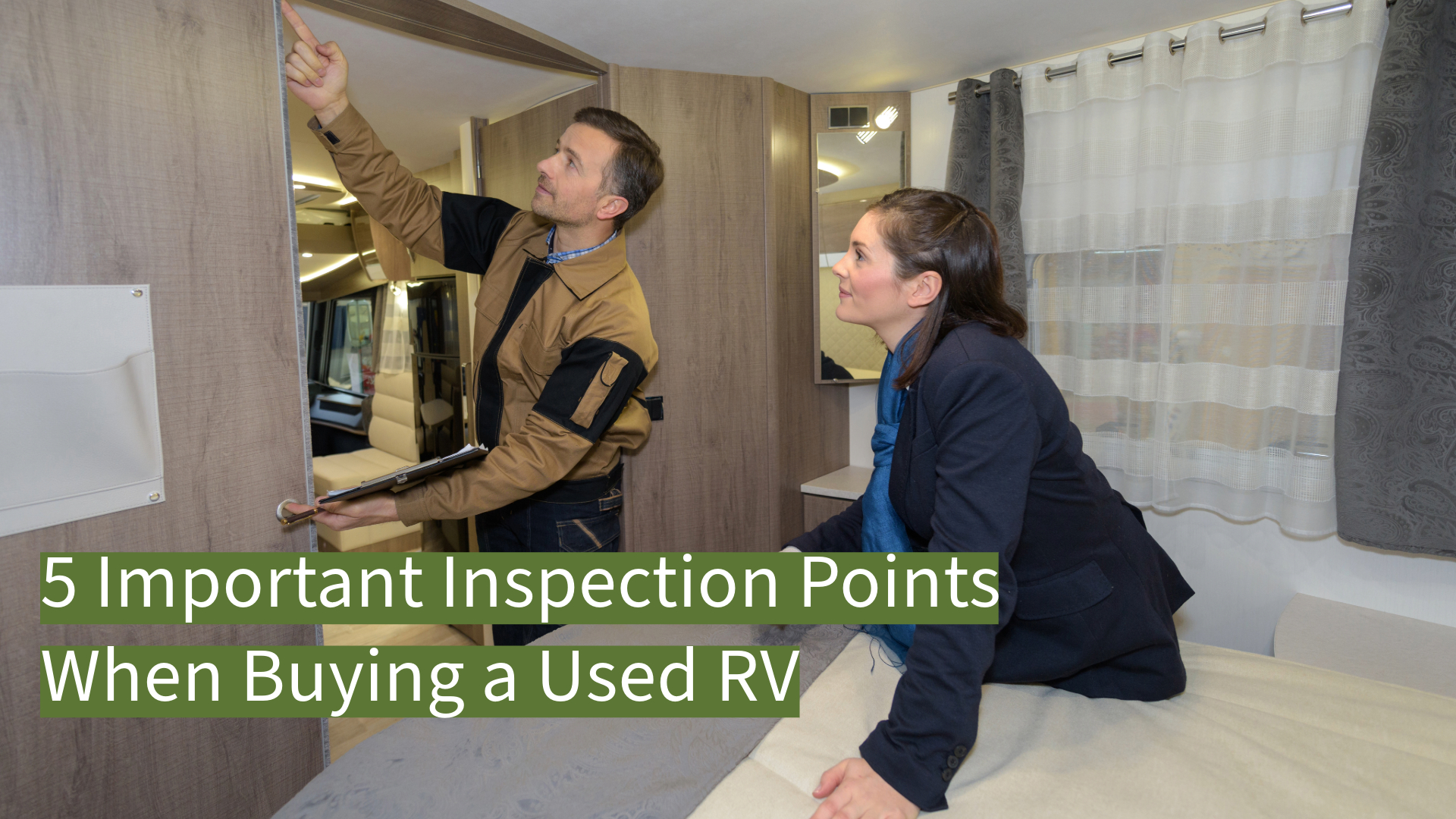If you don’t have the time or knowledge to perform a 500-point NRVIA Premier Inspection when you purchase a used RV and are not able to retain the services of a certified NRVIA Inspector, make sure you check these points, you’ll be glad you did.
Tires
Did you know that tires can “expire”? The NTSB and most tire manufacturers recommend replacing tires regardless of visual condition at 6 years from the date of manufacture. This is because the structure of the tire especially at the sidewall can cause a catastrophic failure and is a life safety issue for not only the owner and occupants of the rig or tow vehicle but also those sharing the road with them. Most tire repair companies will not repair tires beyond this 6-year period and a new complete round of tires can cost from as low as $500 for a fifth wheel or travel trailer up to $10,000 or more for a large Class A with tag axles.
All tires sold in the United States are required to have the date of manufacture stamped on the sidewall. The code is only required to be on one sidewall so it can be difficult to find if the tire was mounted with the code on the inner wall of the tire or between dual tires, while difficult to inspect, it is a vital point to inspect. This is always a 4-digit code, on tires manufactured after January 1, 2000, within a rectangle border. The first 2 digits indicate the week of the year it was manufactured while the next two digits indicate the year of manufacturer.
Slideout Alignment
A properly aligned slideout will operate smoothly not putting undue stress on one or more points and will seal tightly, protecting the interior from water intrusion and preventing very costly damage to the slideout and the RV at large. With the slideout in, on the exterior run your fingers along the slideout seal on all edges, sides, bottom, and if possible the top. It should be a tight fit and you should not be able to insert even a fingertip between the bulb seal and the T-Molding of the slideout wall. If you can easily insert even a fingertip or more water can enter, especially as you travel down the freeway at high speed in the driving rain. Extend the slideout, step back, and look. Is the slide level from back to front? Is it leaning away from the rig when viewed from the side? Is the space between the side wall of the slide and the RV even or is there more of a gap at the top or bottom? Is that same space the same on both sides of the RV or is one side more gapped than the other? If any of these conditions exist it can indicate serious concerns of the structure and components of the slideout that need to be addressed or negotiated for purchase price.
Roof
Your RV roof is the “roof over your head” that you take with you on your camping adventures. In a sense, it’s really the whole point of an RV or you might as well just pack up a sleeping bag and sleep under the stars. In order for it to fulfill its primary objective of keeping you safe, secure, and away from the elements, there are some important things to look for when buying your used RV.
As you climb the ladder to inspect the roof take a look at its condition. Is it secure and safe? Look at the weight rating. Some ladders are rated at 250lbs or less. Do the math and compare your weight to the ladder’s weight rating.
Once upon the roof get on your hands and knees for safety and a closer look. Closely inspect all of the seams along the front and rear caps as well as the trim rails along the side. Is the sealant pliable or is it cracked, drying, has holes or even missing in critical points? Check the sealant around all attachments for good condition. Check for any rips or tears in the roof membrane. Does the membrane form a tight fit on the substructure of the roof or is it “bubbling up” or loose and pulled away from the roof underneath? Is there any evidence of previous repairs to the roof like patched material or tape? Check the condition of all attachments and covers of air conditioners, fans, solar panels, or skylights. As you move around on the roof be aware of any soft spots in the roof structure.
Life Safety
Getting to an adventure destination is only part of the RV experience. Staying safe and keeping others safe on the way and while you’re at your destination is another important and vital consideration.
We’ve reviewed tires previously but let’s not forget about some other very important safety components that come with your RV. As you inspect your rig, test all carbon monoxide, propane, and smoke detectors. These items are often neglected and will fail when you need them most if not maintained. Used RVs especially have a tendency to contain dead batteries in these components. Check that you have a fire extinguisher mounted within 24” of the main entry of your rig. Check that the date of manufacture is less than 12 years old. Check that the gauge reads in the green and is fully charged. Check that it’s the proper size for your rig. The best size and class is 1A-10:BC which extinguishes combustible materials like wood(A) flammable liquids (B) and electrical fires (C) but at minimum, the NFPA code 1192, prior to July 2021, requires a 5:BC for travel trailers and fifth wheels and a 10:BC for motorhomes.
Water Systems
As you inspect your RV, fill all sinks and toilets ¼ full of water for at least 5 minutes. Then, check to see that the bowls/ sinks have held the same volume of water to ensure the stoppers/ seals are fulfilling their purpose. Ensure the water pump pressurizes and holds the pressure. (Listen for the water pump to turn on, it should turn on and then stop. It should not turn on again until you call for water by turning on a faucet or flushing a toilet). When you determine that the sink has held the water, pull the plug while you watch under the sink for any leaking at the P-trap. Check under the sinks for any signs of water damage or leaks. Check the plumbing fittings and ensure they are secure. If a tank-style heater, ensure the water heater has been on for sufficient time and check that hot water is being delivered to your faucets. Run hot water into a mug if possible and place a thermometer in the water. The heater should heat to 130-140. If it does not reach 130-140 degrees your heater is not functioning efficiently and could indicate issues with the burn chamber, electric filament, or buildup of minerals or residue inside the tank. If it is over 140 degrees your thermostat is likely bad and needs to be replaced. On the exterior, open the access panel and view the burn area of the heater. If it is a steel tank (Suburban) it should have a metal drain plug. Attached to that plug is an anode rod that should be regularly maintained and replaced. If an aluminum tank (Dometic) It should have a plastic plug. Under no circumstances should a Dometic have a metal plug or a Suburban have a plastic plug. Check that there is no water leaking from the pressure relief valve. Check the rubber grommet where the propane line enters the burn area. It should be completely sealed with sealant with no holes or cracks or missing sealant. This is a life safety issue as it could otherwise allow entry of dangerous carbon monoxide into the living area of the RV.
These are 5 ways to make your next RV purchase the best investment possible yourself but always consider a complete professional inspection by a Certified NRVIA Inspector. You’ll be glad you did and on your way to being a happy camper.
About Mobiltek RV Services
Since coming “online” in September 2024 Mobiltek RV Services has hit the ground running completing 26 RV pre-purchase inspections and several repair jobs in the Northern California area and even fielded remote service calls by phone. Our customers have come from as far away as Massachusetts to Montana, Missouri, Texas, Arizona, Oregon, and Nevada as well as the local SF Bay Area. Our clients have found us from the NRVIA locator, social media, direct searches to our website, and nationwide RV marketing companies. We have inspected units as old as 2003 up to brand new and our clients have received very valuable insights into the rigs they have been interested in purchasing. Chris and Debbie Murrell of Mobiltek RV Services absolutely love the very valuable work they do and getting to know our clients’ individual stories, their interests and serving them is a great inspiration and motivation to press onward and upward as Mobiltek grows.
This blog was written by Mobiltek at https://mobiltekrvservices.com call us at (925) 263-9735 or shoot us an email at [email protected]

